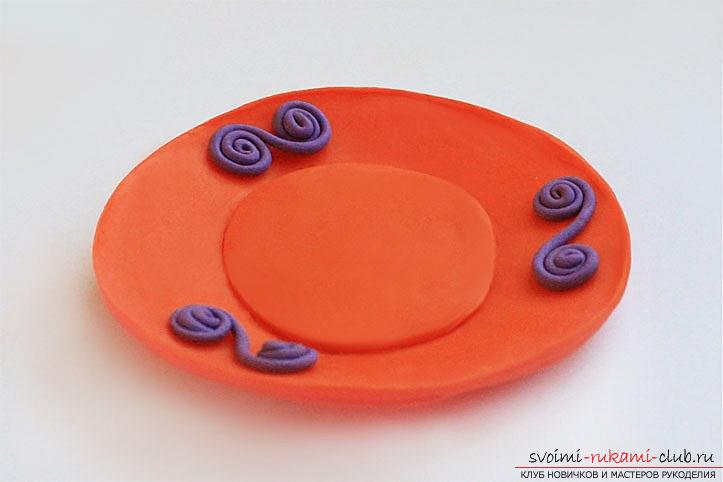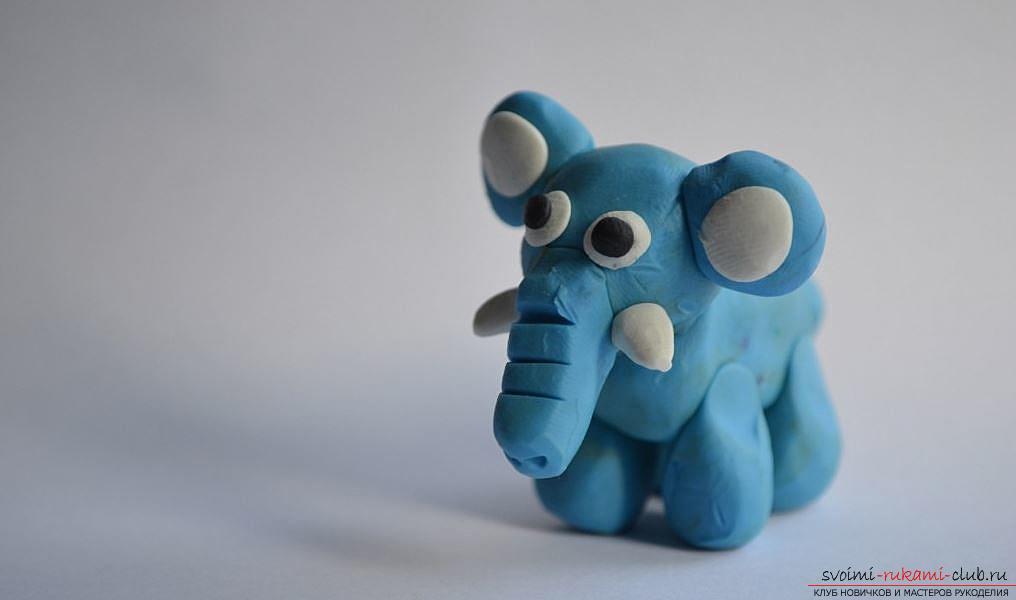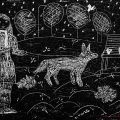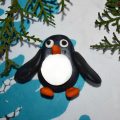
Basic methods of working with plastic materials and types of modeling in the preparatory group.
Such a hobby as a sculpture came into being verylong. Initially sculpting from clay a variety of dishes and other household items was not entertainment, but a necessity. But now, when various plastic materials have appeared, molding turns into pleasant needlework. Polymer clay, dough, plasticine, culinary mastic or marzipan, even gypsum serve to create beautiful and original handicrafts. This passion is engaged in adults and children. For toddlers, modeling is also of great importance for their diversified development. Improves fine motor skills, develops memory, increases vocabulary. Kids learn patience, perseverance, make non-standard decisions and think creatively. The first classes on modeling crafts begin at the age of 3 - 4 years. In comparison with crafts of younger groups, six-year-olds create crafts with greater expressiveness and variety, thanks to the fact that their information stock of images has increased. Musculature of hands and fingers brushes developed and strengthened, speech and thought processes developed. Watching the objects, the little man more fully perceives their form. The orientation in space improves, the kid already understands better how to arrange crafts relative to each other. All these changes affect the visual activity. Children want to transfer the form of the object more accurately, to observe proportions, they are captivated by the creation of additional details that will complement the final image.  The kids already have an understanding that the pens andThe legs of the figures can not only be moved to simulate steps, they already know how to bend them. This gives the crafts greater expressiveness. Children understand how the object of modeling should be located and immediately determine its main part. Here runs a rabbit, he runs away from the fox. The baby immediately correctly determines the correct location of a piece of modeling material for a running bunny. More often in the classroom, drawing parts from one whole piece and stack is used. Of course, kids at the age of six are better able to convey the characteristic features of the shape of objects, but it is still difficult for them to display individual details, and they unconsciously discard them. The transfer of the characteristic features of form and structure still looks generalized. The head for them is a ball, the trunk is an oval. Therefore, the tasks facing teachers and the training program in the preparatory group are much more complex and full. Babies need to master additional technical methods of imaging, to learn visually and muscularly perceive the shape of the object. Six-year-olds know several methods of working with materials, but the main one must be a method of sculpting from one piece - plastic. Together with this, knowing how to sculpt three-dimensional objects (balls, cones, cylinders), kids need to determine the original form for the creation of the craft. Educators and teachers contribute to the development of creative initiative, give the right to choose the topic for the kids, and also by what means and ways they will do the work. The entire program for convenience is better divided into quarters. In the autumn, the main task is to teach the children how to sculpt the characteristic shape of the object. As always, the children remember the last lessons - they make vegetables. In this case, the tasks will become more complicated - it is necessary to mold several homogeneous objects that differ in shape. Here's an apple. It is more elongated or vice versa, round. Or it can be different in shape cucumbers. You can put all the children's crafts in one basket, making a general composition. When several lessons take place, the kids will be able to create individual compositions. Bright colors of plasticine or dough will be additional expressive means. Children should learn how to sculpt crafts based on the models depicting the action. Here the cock raised the head, and here is the kitten, who plays with a ball. Considering the model, the kid should understand the direction of the form and establish the base part (for example, the torso of the kitten) in the position in which the model is located. Molding on the representation of animals. In this case, the kids need to clearly represent the nature of the shape of the main part and the special details that differentiate this animal from the others. What makes a big sheepdog from a small and fluffy lapdog, a cockerel from a chicken. Modeling without a specific model set before your eyes allows you to fantasize when depicting the position of parts of an object, its actions or textures. Kids can freely use different methods and methods of work. Pull out of one piece, collect hand-made articles for details, use a stack to convey the relief and texture or apply methods of nalepa. Also, children are free to choose the position of the craft. Here is a kitty, she can curl up into a ball, sit, leaning on front legs and hooking up the back, playing with a ball, hunt for the mouse. Making a craft from memory, the children refresh memories of the structure of animals, obtained from ordinary observations in life and when creating crafts from nature.
The kids already have an understanding that the pens andThe legs of the figures can not only be moved to simulate steps, they already know how to bend them. This gives the crafts greater expressiveness. Children understand how the object of modeling should be located and immediately determine its main part. Here runs a rabbit, he runs away from the fox. The baby immediately correctly determines the correct location of a piece of modeling material for a running bunny. More often in the classroom, drawing parts from one whole piece and stack is used. Of course, kids at the age of six are better able to convey the characteristic features of the shape of objects, but it is still difficult for them to display individual details, and they unconsciously discard them. The transfer of the characteristic features of form and structure still looks generalized. The head for them is a ball, the trunk is an oval. Therefore, the tasks facing teachers and the training program in the preparatory group are much more complex and full. Babies need to master additional technical methods of imaging, to learn visually and muscularly perceive the shape of the object. Six-year-olds know several methods of working with materials, but the main one must be a method of sculpting from one piece - plastic. Together with this, knowing how to sculpt three-dimensional objects (balls, cones, cylinders), kids need to determine the original form for the creation of the craft. Educators and teachers contribute to the development of creative initiative, give the right to choose the topic for the kids, and also by what means and ways they will do the work. The entire program for convenience is better divided into quarters. In the autumn, the main task is to teach the children how to sculpt the characteristic shape of the object. As always, the children remember the last lessons - they make vegetables. In this case, the tasks will become more complicated - it is necessary to mold several homogeneous objects that differ in shape. Here's an apple. It is more elongated or vice versa, round. Or it can be different in shape cucumbers. You can put all the children's crafts in one basket, making a general composition. When several lessons take place, the kids will be able to create individual compositions. Bright colors of plasticine or dough will be additional expressive means. Children should learn how to sculpt crafts based on the models depicting the action. Here the cock raised the head, and here is the kitten, who plays with a ball. Considering the model, the kid should understand the direction of the form and establish the base part (for example, the torso of the kitten) in the position in which the model is located. Molding on the representation of animals. In this case, the kids need to clearly represent the nature of the shape of the main part and the special details that differentiate this animal from the others. What makes a big sheepdog from a small and fluffy lapdog, a cockerel from a chicken. Modeling without a specific model set before your eyes allows you to fantasize when depicting the position of parts of an object, its actions or textures. Kids can freely use different methods and methods of work. Pull out of one piece, collect hand-made articles for details, use a stack to convey the relief and texture or apply methods of nalepa. Also, children are free to choose the position of the craft. Here is a kitty, she can curl up into a ball, sit, leaning on front legs and hooking up the back, playing with a ball, hunt for the mouse. Making a craft from memory, the children refresh memories of the structure of animals, obtained from ordinary observations in life and when creating crafts from nature.  For a successfully crafted craft,how well its parts are connected. Kids learn not only to attach one to another, but to make holes or grooves in one and insert the other there. Also, children continue to learn how to place figurines on legs in an upright position and sculpt men. As a rule, modeling is conducted from life. The role of the model is the doll. Babies disassemble its proportions, for example, how many times the size of the head fit along the length of the entire body. Also, children can sculpt various characters of fairy tales and cartoons, as with models, and memories, and imagination. Teachers offer to sculpt figures of people in dynamics, for example, going to school of the kid, the most kind or the most evil character of the favorite work. Such tasks develop imagination and imagination and help reinforce the methods and methods of working with plastic materials that have been learned previously. Here is the character of the cartoon "Ugly I" - Crew. He has a long sharp nose. Or a cute and funny minion. Kids are happy to blind such details as glasses.
For a successfully crafted craft,how well its parts are connected. Kids learn not only to attach one to another, but to make holes or grooves in one and insert the other there. Also, children continue to learn how to place figurines on legs in an upright position and sculpt men. As a rule, modeling is conducted from life. The role of the model is the doll. Babies disassemble its proportions, for example, how many times the size of the head fit along the length of the entire body. Also, children can sculpt various characters of fairy tales and cartoons, as with models, and memories, and imagination. Teachers offer to sculpt figures of people in dynamics, for example, going to school of the kid, the most kind or the most evil character of the favorite work. Such tasks develop imagination and imagination and help reinforce the methods and methods of working with plastic materials that have been learned previously. Here is the character of the cartoon "Ugly I" - Crew. He has a long sharp nose. Or a cute and funny minion. Kids are happy to blind such details as glasses.  In winter, the lessons of molding are continued by the plastic method. Kids are trained in creating compositions from several (2 - 3) figures. The teacher shows the kids how to use additional support points for the figures standing on their feet. Here is a girl, she sculpts a snowman. The figure can be put on the legs and make the snowball the third point of support. The study of the methods for modeling tableware is also continuing. To the already known, with the help of sausages, folded by a ring, the method is added, when the kid takes out a few pieces of material with the help of a stack of clay, creating a depression. In one handle, you need to hold a cylinder or ball of plasticine, and the second using the stack to make a groove. You can get a cup, vase or a pot.
In winter, the lessons of molding are continued by the plastic method. Kids are trained in creating compositions from several (2 - 3) figures. The teacher shows the kids how to use additional support points for the figures standing on their feet. Here is a girl, she sculpts a snowman. The figure can be put on the legs and make the snowball the third point of support. The study of the methods for modeling tableware is also continuing. To the already known, with the help of sausages, folded by a ring, the method is added, when the kid takes out a few pieces of material with the help of a stack of clay, creating a depression. In one handle, you need to hold a cylinder or ball of plasticine, and the second using the stack to make a groove. You can get a cup, vase or a pot.  In the spring, preference is given to modeling from memory andfantasy, only occasionally diluting it with modeling from life (most often pictures). The theme of modeling can be a zoo. To model animals, babies need a large supply of visual images. To help, children can also be offered giraffe toys, a hippo or a bear cub. Creating these crafts, the kids make their own decisions about the method of modeling or position of the animal. Here is the elephant. His head and trunk can be douched from one piece by a plastic method, and then blind the trunk and other parts and adorn them.
In the spring, preference is given to modeling from memory andfantasy, only occasionally diluting it with modeling from life (most often pictures). The theme of modeling can be a zoo. To model animals, babies need a large supply of visual images. To help, children can also be offered giraffe toys, a hippo or a bear cub. Creating these crafts, the kids make their own decisions about the method of modeling or position of the animal. Here is the elephant. His head and trunk can be douched from one piece by a plastic method, and then blind the trunk and other parts and adorn them.  In the last quarter, the kids fix the receivedknowledge. In the preparatory group, classes can be subject, subject and decorative. Themes for any of them can be chosen by the teacher or the kids themselves. The first two options modeling the baby's best sign. In all the lessons should include a game moment. You can, for example, tell the kids the plot about the pottery, then the kids will play with pleasure in the potters, they can do many different dishes and organize a fair. Decorative modeling involves creating crafts for decorating or, for example, greeting cards as a gift to your beloved mother or maybe a pretty six-year-old lady from the same six-year-old gentleman. For such a postcard, you need a preliminary sketch drawing. And then the details are already attached to it. It can be flowers, the sun, in general, all that will tell the fantasy of the kids. An important developmental role is played by the workplace. Earlier it was prepared for teachers by teachers. They put the children in their places, gave them tools and clay (clay, etc.) in the preparatory group, a small man independently chooses for himself the tools for work and the amount of plastic material.
In the last quarter, the kids fix the receivedknowledge. In the preparatory group, classes can be subject, subject and decorative. Themes for any of them can be chosen by the teacher or the kids themselves. The first two options modeling the baby's best sign. In all the lessons should include a game moment. You can, for example, tell the kids the plot about the pottery, then the kids will play with pleasure in the potters, they can do many different dishes and organize a fair. Decorative modeling involves creating crafts for decorating or, for example, greeting cards as a gift to your beloved mother or maybe a pretty six-year-old lady from the same six-year-old gentleman. For such a postcard, you need a preliminary sketch drawing. And then the details are already attached to it. It can be flowers, the sun, in general, all that will tell the fantasy of the kids. An important developmental role is played by the workplace. Earlier it was prepared for teachers by teachers. They put the children in their places, gave them tools and clay (clay, etc.) in the preparatory group, a small man independently chooses for himself the tools for work and the amount of plastic material.



